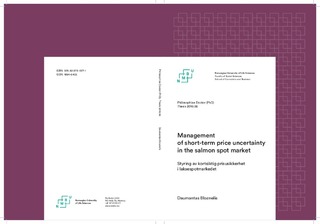| dc.description.abstract | The spot price of Norwegian farmed Atlantic salmon is highly volatile and hard to predict. The uncertainty over the future spot price obscures revenue projections of salmon farmers and cost expectations of processors, exporters and retailers. It also makes business financing expensive as the high uncertainty needs to be compensated by a high return on investment. The market participants acknowledge this to be a substantial quandary. This thesis examines the problem and aims to provide
feasible solutions for uncertainty management in the salmon market.
An introduction and three research papers address the different aspects of the subject, namely, salmon price volatility, price predictability and hedging the spot price with various financial instruments. A variety of econometric and machine learning techniques are applied to account for seasonal patterns and autoregressive conditional heteroskedasticity in the price series and to deliver forecasts of their conditional means and variances. The first paper “Salmon price volatility: a weightclass-specific multivariate approach” presents a statistical description of the conditional mean and variance of the spot prices of seven different weight classes of salmon. It highlights a considerable increase in the unconditional variance around 2006, which coincides with a change in industry regulations and the introduction of a futures exchange for salmon. The conditional mean and variance patterns are found to be similar across the neighbouring weight classes, and the conditional correlations are nearly perfect since 2007. This allows treating the three most popular weight classes of 3-4 kg, 4-5 kg and 5-6 kg as one and makes hedging with salmon futures relatively attractive. The second paper “Short-term salmon price forecasting” is a comprehensive study of forecasting the spot price one to five weeks ahead. It employs three different classes of forecasting models: (1) time series models broadly based on the ARIMA model; (2) artificial neural networks; and (3) a custom model based on the k-nearest neighbours method. Six measures of forecast accuracy and seven tests of forecast optimality and encompassing are reported. The salmon price appears to have a partly predictable seasonal component; however, statistical significance of predictability cannot be established at the available sample size, and the economic value of forecasts is limited. Also, unpredictability beyond seasonality does not offer evidence against weak form efficiency of the salmon spot market. The third paper “Hedging salmon price risk” examines the hedging performance of salmon futures, live cattle futures, soybean meal and oil futures, and the share price of Marine Harvest on the Oslo Stock Exchange. Considerable attention is paid to defining a relevant objective function for a hedger in the salmon market, and a new measure of hedging effectiveness is proposed. Among the candidate hedging instruments and their combinations, the salmon futures contract offers the highest hedging effectiveness; however, low liquidity may limit its applicability in practice. In conclusion, the high uncertainty in the future spot price of salmon has been a constant predicament to the market participants and asks for a practical response. The research results contained in this thesis indicate that attempts of predicting the spot price might not deliver satisfactory results. However, hedging the price risk with salmon futures offers a substantial reduction in uncertainty and could therefore be promoted, provided that the futures contract attracts enough liquidity to meet the demand for hedging. The data used in the thesis is publicly and freely available, and the models are documented in detail; hence, they may be readily employed by the market participants in their business planning and optimization. | nb_NO |

